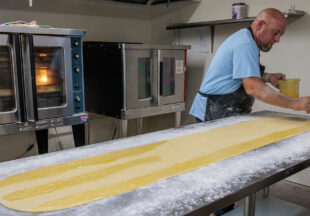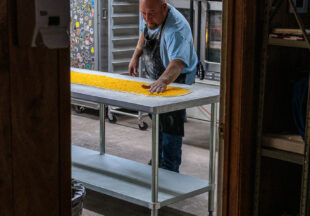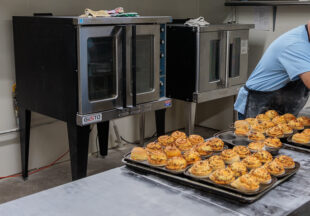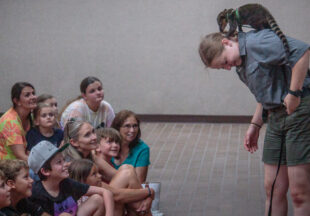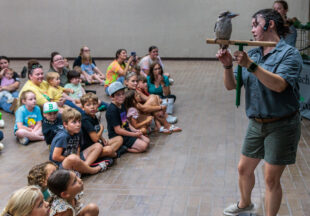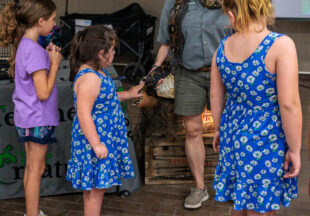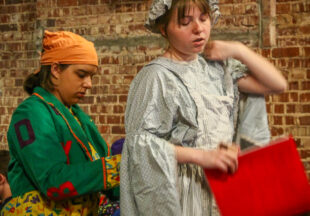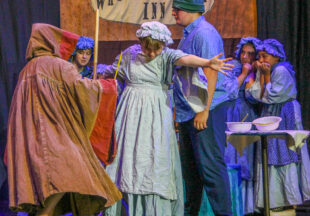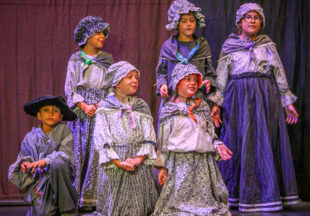Is there a new school in Breckenridge’s future?
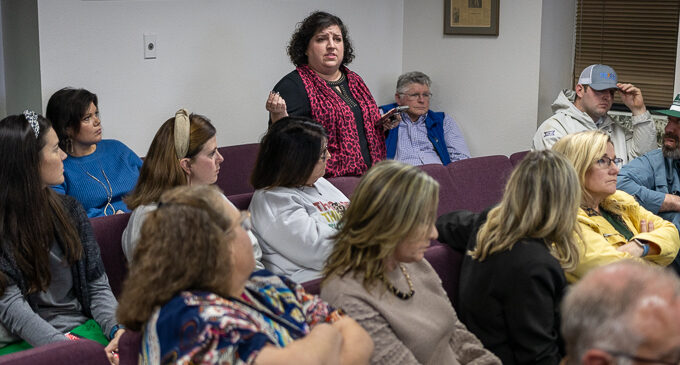
By Carla McKeown/Breckenridge Texan
Breckenridge could get a new elementary school — or maybe major renovations to existing schools — in the near future. But, before any serious plans can be made, the Breckenridge Independent School District’s Board of Trustees must decide which direction to take, and then the voters in the school district must approve a tax via a bond election in May or November to pay for either a new school or renovations.
The school district has been studying the situation for almost two years. Everyone agrees that something needs to be done, but they don’t all necessarily agree on exactly what that something is. Some of the options that have been discussed include building a new kindergarten through fifth grade school, building a new pre-K through fifth grade school, renovating South and East elementaries, and doing some less extensive renovations to the junior high and high school buildings.
For the past several months, a community advisory committee has been working with a design firm to come up with the basic plans. In a special meeting earlier this month and at the regular meeting last week, school board members took a look at some of the ideas and heard feedback from the committee members and the design firm.
“We had a lot of different discussions about what we wanted, but there was one thing that was 100 percent consensus, and that is we need to do something,” said Carl Everett, a member of the advisory committee. “It was just what we’re going to do from our choices and what we can afford. And you know, this school system is for the kids. But it’s also for the employees. And it’s also for the taxpayer. It’s three-pronged. And it doesn’t do any good to go all one way or all the other way. You got to balance all that stuff out.”
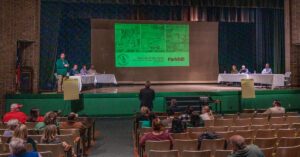
BISD Superintendent Bryan Allen, on the left on stage, introduces Mike Baker with Parkhill, center, at a special school board meeting held in Bailey Auditorium earlier this month. Baker presented ideas from a Citizens Advisory Committee and Parkhill representatives about building a new school for Breckenridge. (Photo by Tony Pilkington/Breckenridge Texan)
The Research
The project kicked off in October 2022 when the school board contracted with the Texas Association of School Boards to conduct a facilities assessment of the Breckenridge schools. In May of last year, TASB presented its report, documenting an estimated $76 million worth of issues that need to be corrected.
In September 2023, the school board started working with Parkhill, an architect and engineering firm that specializes in school buildings as well as other government and commercial facilities, to come up with a plan. Additionally, Live Oak Public Finance has been working with BISD on how to finance the project. A citizens advisory committee composed of local community members and school district personnel was formed last fall. The committee met with Parkhill and Live Oak representatives in October, November, December and earlier this month.

Mike Baker with Parkhill talks to the school board at their Jan. 23 meeting about the options for either building a new school or renovating current schools. (Photo by Tony Pilkington/Breckenridge Texan)
On Jan. 10, the committee, Parkhill and Live Oak met with the school board in a public meeting in Bailey Auditorium for a progress report. Based on their review of the TASB assessment, tours of the schools and meetings with committee, Parkhill representatives presented several options for how BISD can improve the district’s facilities. Then, John Blackburn with Live Oak presented a variety of scenarios for raising the funds through bonds.
The Parkhill representatives returned for the Jan. 23 school board meeting. At both the Jan. 10 and 23 meetings, there was continued discussion between the committee members and the Parkhill representatives about the specifics of the plan.
Parkhill has presented several options to the school board, ranging in price from less than $40 million to over $50 million, depending on whether or not a new school is built or renovations are done to existing schools instead, as well as the size of the new school and/or the extent of the renovations. Parkhill’s numbers are lower than the TASB estimate because they don’t propose fixing every problem at one time; another project and bond may be necessary in the future.
At the Jan. 23 meeting, Community Advisory Committee member Jaclyn Morehart spoke about the work the committee has done. “The Citizens Advisory Committee, which has a lot of people in this room, we’ve been meeting the last several months. We’ve met five different times; we’ve been at three out of the four campuses, we did not meet at the junior high,” she said. “These meetings have been three-plus hours long. … There’s been a lot discussed; it’s not been taken lightly.”
During the last committee meeting, a vote was taken, and a majority of the committee members voted for the building of a new elementary school for kindergarten through fifth grade. The others voted for a less expensive option of renovating several of the campuses.
“It was majority; it wasn’t a unanimous vote,” Morehart said. “One thing we did unanimously agree on is South Elementary is in the worst condition out of all the campuses. That goes along with what TASB has found and what Parkhill has found, and just what we’ve seen by touring it and just having children that attend the school.
“(Director of District Services for BISD) Mitch Brewer, he presented us some information on maintenance costs per square foot at each of the campuses,” she continued. “And that also aligned with the fact that South Elementary is costing us the most money to operate. It’s at the highest cost per square foot. So basically, I’m just letting y’all know, just just being honest, it’s not all sunshine and rainbows and we want a new school … and everything’s just gonna magically happen. A lot of people have put a lot a lot into this.”
The Options
Although the potential costs for the various plans have fluctuated, depending on several factors, the basic plans range from $40 million for renovations of South Elementary and some work on East Elementary and the high school and junior to almost $48 million for a new school for kindergarten through fifth grade (with Early Childhood, Head Start and Pre-K remaining at East) or more than $52 million for a new school that would include all of the elementary grades.
Those costs do not include the cost of purchasing land for the location of a new school. However, the Parkhill representatives explained that if they build a new school for BISD, it will include everything, including classroom furniture, to be ready to use when it is finished.
“That includes the school; that includes the site work, the utilities, all of the furniture, the IT systems, HVAC systems, playgrounds. It’s a turnkey school; everything that you need will be in there,” Mike Baker with Parkhill said at the Jan. 10 meeting. “Plus, it includes the engineering fees, architecture, fees, survey, material testing that the contractor has to do, all of your TDLR accessibility inspections and reviews, storm shelter reviews and inspections. All of those things come together to really build what we call a bond budget. And that’s the number that you will ultimately have to consider — the board will consider. And if everyone agrees, that will be what the bond amount will be. But I want to make sure everybody is clear that that is not just the building cost. … We just want to make sure everybody understands that we talked about a turnkey facility with all the extra work that needs to go into it from all the consultants.”

Parkhill representatives presented three options to the BISD school board at the Jan. 23 meeting. Click to enlarge.
The K-5 school was the most popular option that the committee and Parkhill representatives returned to during all of the presentations. After the last committee meeting before the Jan. 23 school board meeting, a majority of the committee members agreed to recommend the K-5 school option. However, at the Jan. 23 meeting, the cost of the school was almost $3 million more than they had discussed earlier, going from $45 million to $47.8 million. Baker explained that his team had talked with the principals, who requested an additional classroom per grade level, which increased the cost of the project.
If a K-5 school is built, there will likely still be a need for some renovations at East Elementary to improve it for the younger school children.
The K-5 plan, which Parkhill recommends, will include a new kindergarten through fifth grade elementary school on a new site (not yet determined), the demolition of South Elementary and the demolition of the oldest portion of East Elementary, leaving the 2005 addition, as well as the dining and administration areas, to be used for Early Childhood, Head Start and Pre-K classes. That cost is estimated at $47.8 million, although that is not a formal bid.
A cheaper option is estimated to cost between $36 million and $40 million, depending on the extent of the work. That would include major renovations and an addition to South Elementary ($26 million), a new high school band hall/storm shelter and CTE (career and technical education) department renovation ($11 million), some renovations at the junior high to create a secure vestibule and rework the administration area ($1 million), and some renovations at East, including a secure vestibule, covered walkways, heating and air conditioning upgrades to the gym, and painting ($2 million). Some adjustments could be made to each of those plans to reduce the cost to as low as $36 million.
And the most expensive option presented by Parkhill is a new elementary that would include all of Breckenridge’s elementary students, from Early Childhood classes through fifth grade, on a new site. That would cost about $52.4 million and would also include the demolition of South Elementary and the demolition of the oldest part of East Elementary and the repurposing of the remaining building there.
Although some members of the committee preferred the cheaper option, some drawbacks include that the students will have to be displaced, possibly to portable buildings in the parking lot, during the extensive renovations and when the project is finished, BISD will still have two aging elementary schools, parts of which were built more than 60 years ago.
Another concern for some of the committee members is that the tax rate to pay off the bond the district will get to pay for a new school will not be acceptable to Breckenridge voters. See the “Paying for it” section below.
There are other options that can be considered, such as building a new K-5 school with room to expand it in the future to include the younger students, building a two-story school, building a new school on the current South Elementary location, and others. The Parkhill representatives and committee members explained that each option has benefits and drawbacks, such as having to relocate students while a new building is constructed on a current location.
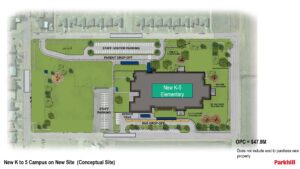
This artist’s rendition of a new school site represents the type of school Breckenridge could get. At this point, it’s just an idea and is not necessarily what the final project will look like, if approved by the school board and voters. (Courtesy of Parkhill)
Paying for it
The money to pay for typical school expenses — everything from teacher salaries and maintenance to renovations and new buildings — comes from property taxes paid by people who own property in the district, as well as from some state and federal funds. The taxes are divided into two categories — maintenance and operations (M&O) and interest and sinking (I&S), which is used to pay for debt.

John Blackburn with Live Oak Public Finance answers questions during the Jan. 10 BISD meeting in Bailey Auditorium. (Photo by Tony Pilkington/Breckenridge Texan)
To get the money to build a new school or do major renovations, school districts sell bonds to investors. Then, the I&S tax funds are used to pay off the principal and interest on the bonds.
In 2019, with local voter approval, BISD did away with the I&S tax and combined it all into the M&O tax, so some of the M&O tax money has been used to pay off previous debt. Last year, the school board voted to pay off the existing debt early, in February 2024.
According to the charts and graphs presented to the school board by John Blackburn with Live Oak Public Finance, Breckenridge’s current $0.7575 tax rate is the second-0lowest school property tax rate in the area. The data Blackburn presented shows Albany ISD at $0.7380. Other school districts in the area have a higher tax rate than BISD: Eastland, $0.8200; Woodson, $0.8263; Graham, $1.0239; Throckmorton, $1.1702.
Additionally, BISD’s tax rate is at its lowest rate in 20 years. Past BISD tax rates have included $1.500 in 2006 and $1.496 in 2007. From 2008-2018, it ranged from $1.1785 to $1.1025. It was $1.1700 in 2019 and has dropped steadily since then.
BISD’s current tax rate of $0.7575 per $100 property valuation means that property owners pay a little over 75 cents per $100 value of their home. Additionally, the homestead exemption was raised to $100,000 after approval by statewide voters last year. So, for a home that is valued at $200,000 and is covered by the homestead exemption, the property owner will owe $757.50 in taxes to the school district at the current rate. People with homes valued at $100,000 or less will not owe school district taxes.
In order to raise the $47.8 million for a new school, BISD will need to add an I&S tax of 42 cents, for a total of $1.1775 per $100 property valuation, according to Blackburn. That means, that the person with the $200,000 house would owe an additional $420, for a total of $1,177.50.
Some members of the committee expressed concern that the $0.42 additional tax is too much and that the voters won’t approve it. Lower tax rates will raise less money, which means the district likely would not be able to afford a new school. For example, according to information from Live Oak, a 35-cent tax would raise $39.65 million, and a 30-cent tax would raise $34.015 million.
Changes in property values in the district would alter the funds generated by each tax rate. For example, one of Live Oak’s presentations includes information showing that with 10% growth and a 15% increase in property values, a $0.40 rate would raise $51.8 million.
“I visited with my local tax office, and I made me a little spreadsheet yesterday,” Jaclyn Morehart said at the Jan. 23 meeting. “I’m a community member. I’m a parent of kids in the school district. I’m a business owner, and I have rental properties. Amongst all my valuations and whatnot, my BISD taxes alone are going to go up $5,000 with this. I’m willing to pay $5,000 a year for this. But I can’t speak for other business owners … or other people that own real estate. I don’t know how it affects everyone. And this is just assuming that the city doesn’t raise their rates, that everything else stays the same, valuation doesn’t raise. It’s going to cost me $5,000. And I’ll pay it, but I just don’t know if Joe Blow will pay it.”
Going Forward
In order to get a proposal on the May election ballot, the school board will need to make a decision at their February board meeting. If they don’t agree on a general plan and proposed tax rate, the earliest the community could vote on it would be in November.
Cutline, top photo: Citizens Advisory Committee member Jaclyn Morehart, center, addresses the Breckenridge school board during the Jan. 23 meeting. Also attending the meeting were other committee members and others interested in the possibility of a new school. (Photo by Tony Pilkington/Breckenridge Texan)











